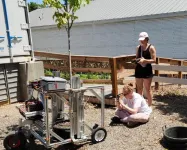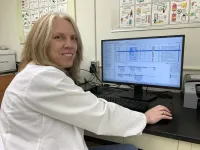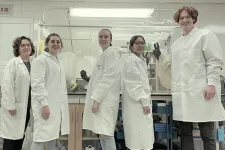(Press-News.org) University of Tennessee Extension and UT AgResearch scientists have been awarded part of a nearly $10 million grant from the U.S. Department of Agriculture to study ways to use automation and robotics to address the labor shortage in the nursery crops industry.
Growing plants in a nursery is highly dependent on manual labor, making this industry particularly prone to worker shortages. An increasingly scarce workforce is limiting production, economic development and prosperity in the rural communicates where nurseries are predominantly located. The UT Institute of Agriculture scientists who are part of the Labor, Efficiency, Automation and Production (LEAP) Team have been working alongside nursery partners in Tennessee and researchers from eight other universities and institutions to address the growing nursery workforce deficit. LEAP has been awarded a five-year $9.8 million grant from the USDA National Institute of Food and Agriculture’s Specialty Crops Research Initiative, and $3.6 million of that is designated for UTIA research and extension.
LEAP focuses on automation of repetitive, arduous tasks to reduce the reliance on many workers and improve worker engagement and wellbeing. The initiative aims to develop new technologies as well as interactive economic decision-making tools, online classes, an industry mentoring program and other resources to accelerate the adoption of these advancements in the nursery crops industry.
“The industry is facing challenges that will require producers to be more efficient with the limited labor that is available,” shared John Turner, co-owner of Turner & Sons Nursery in Smithville, Tennessee. UT’s Amy Fulcher explained, “Lack of labor has reached a crisis point that jeopardizes the U.S. nursery industry’s future. We know from our national survey that nursery producers are adopting automation to address the labor shortage, yet existing technologies are adopted on average by just one in three nurseries. Individual tasks are 31% or less automated, an increase from 18% in 2006, but we have to increase that. Luckily, we have innovative nursery partners in Tennessee who share that vision.” Terry Hines, owner of Hale and Hines Nursery in McMinnville, Tennessee, explained, “Over the last few years, we have increased our salaries and added benefits, and yet it is still difficult to recruit and retain qualified workers. We have found that innovating and investing in automation is essential to a sustainable future.”
Fulcher, a professor in the Department of Plant Sciences and co-Project Director of LEAP, worked with a USDA-ARS scientist and fellow member of the LEAP engineering team on the development of intelligent spray technology that uses sensors to tailor pesticide application from each nozzle to a plant’s physical characteristics in real-time. The successful development and commercialization of this spray technology was a cornerstone of the LEAP project.
UTIA researchers who are part of LEAP with Fulcher include:
Natalie Bumgarner, associate professor in the Department of Plant Sciences
Le Chen, assistant professor in the Department of Agricultural and Resource Economics
Hao Gan, assistant professor in the Department of Biosystems Engineering and Soil Science
Alicia Rihn, assistant professor in the Department of Agricultural and Resource Economics
Taylor Ruth, assistant professor in the Department of Agricultural Leadership, Education and Communications
Susan Schexnayder, senior research associate in the School of Natural Resources
Margarita Velandia, professor in the Department of Agricultural and Resource Economics
The LEAP Team is developing automation technology to help nursery growers with tasks such as lifting potted plants, eradicating weeds, inventorying crops in the field and detecting insect pests before they damage plants.
Under the direction of Gan, undergraduate senior design students in the Department of Biosystems Engineering and Soil Science created an award-winning early prototype of a harvesting robot called PIPER (Pot-in-Pot Extraction Robot). TALI, a Terrestrial Automatic Laser-based Inventory system, will be developed in partnership with the USDA to automatically count trees and record individual tree dimensions and canopy density. TALI builds on the intelligent spray technology developed by the USDA-ARS, Fulcher and others at UTIA, and Tennessee nursery and orchard collaborators that is currently sold worldwide as Smart Apply.
Another technology – ANDREW (Autonomous Nursery Driving Robot for Eliminating Weeds) – is being developed at Carnegie Mellon University. Advanced prototypes of PIPER, TALI, and ANDREW will be tested at UT’s East Tennessee AgResearch and Education Center (ETREC) Plant Sciences Unit and collaborating Tennessee nurseries.
The LEAP Team is also helping small-scale growers adopt existing, low-cost technology to apply fertilizers, herbicides and irrigation more labor efficiently. LEAP Team economists Chen, Rihn and Velandia will assess the economic viability of automated technologies and evaluate the impact of technology on employee productivity, retention, health and satisfaction. Rihn, Ruth, and Schexnayder will work with a UF LEAP Team member to map growers’ information-sharing networks that accelerate adoption; and Bumgarner, Rihn, and Ruth will assess consumer perception of the benefits of technology use in nurseries and assess consumers’ willingness to pay for these benefits. Ruth will also develop messaging that promotes the adoption of nursery technology and inform strategic communication.
LEAP, led by Anthony LeBude, an Extension Specialist at N.C. State University, includes UTIA, Tennessee State University, Carnegie Mellon University, the University of Georgia, the University of Florida, Oregon State University, Texas A&M University, and the USDA-ARS. Many nursery crops growers in Tennessee and across the U.S. are collaborating partners, hosting research and extension efforts related to the grant.
The University of Tennessee Institute of Agriculture is comprised of the Herbert College of Agriculture, UT College of Veterinary Medicine, UT AgResearch and UT Extension. Through its land-grant mission of teaching, research and outreach, the Institute touches lives and provides Real. Life. Solutions. to Tennesseans and beyond. utia.tennessee.edu.
END
UTIA researchers win grant for automation technology for nursery industry
Efforts will help nursery growers compensate for lack of workers
2024-09-19
ELSE PRESS RELEASES FROM THIS DATE:
Can captive tigers be part of the effort to save wild populations?
2024-09-19
Captive tigers in the United States outnumber those living in the wild. The World Wildlife Federation estimates around 5,000 of the big cats reside in the U.S., mostly owned by private citizens.
The health of this population is a genetic mystery for conservation groups and researchers interested in how the captive tigers could help stabilize or restore wild tiger populations. Are the privately owned animals just like tigers in the wild, or do they reflect characteristics popular in the illegal trade? Are they a hodgepodge of wild tiger ancestry, ...
The Ocean Corporation collaborates with UTHealth Houston on Space Medicine Fellowship program
2024-09-19
UTHealth Houston and The Ocean Corporation are collaborating on UTHealth Houston’s Space Medicine Training Fellowship program, which now includes a two-week intensive training focused on hyperbaric technologies and analog environments akin to those astronauts experience during extravehicular activities (EVAs), or space walks.
The training will enhance the hands-on learning experience of fellows in the Space Medicine Fellowship program, giving them a deeper understanding of physiological and medical challenges encountered in extreme environments.
“Integrating ...
Mysteries of the bizarre ‘pseudogap’ in quantum physics finally untangled
2024-09-19
By cleverly applying a computational technique, scientists have made a breakthrough in understanding the ‘pseudogap,’ a long-standing puzzle in quantum physics with close ties to superconductivity. The discovery, presented in the September 20 issue of Science, will help scientists in their quest for room-temperature superconductivity, a holy grail of condensed matter physics that would enable lossless power transmission, faster MRI machines and superfast levitating trains.
Certain materials involving copper and oxygen display superconductivity (where electricity flows without resistance) at relatively high — but still frigid — temperatures below ...
Study: Proteins in tooth enamel offer window into human wellness
2024-09-19
A new way of looking at tooth enamel could give scientists a path to deeper understanding of the health of human populations, from the ancient to the modern.
The method, published this week in the Journal of Archaeological Science, examines two immune proteins found embedded in human tooth enamel: immunoglobulin G, an antibody that fights infection, and C-reactive protein, which is present during inflammation in the body.
“These proteins are present in tooth enamel, and they are something we can use to study the ...
New cancer cachexia treatment boosts weight gain and patient activity
2024-09-19
Researchers discovered a drug that safely and effectively helped cancer patients when they suffered from cachexia (ku-KEK-see-uh), a common condition related to cancer that involves weight loss and muscle wasting.
The results of the randomized phase 2 clinical trial, which included187 individuals who experienced cachexia with lung, pancreatic, or colorectal cancer, were reported in the New England Journal of Medicine on Sept. 14, 2024. Richard Dunne, MD, MS, a Wilmot Cancer Institute oncologist and cachexia expert was part of the large group of investigators ...
Rensselaer researcher receives $3 million grant to explore gut health
2024-09-19
Blanca Barquera's investigation into the energy-generating processes of Bacteroides, the most abundant member of the gut microbiome, and their impact on our well-being holds the promise of significant advancements in human health. Barquera is a professor at Rensselaer Polytechnic Institute in the Departments of Biological Sciences and Chemistry and Chemical Biology.
In recent years, it has become increasingly clear that an unhealthy gut is more than just a source of digestive troubles. A healthy ...
Elam named as a Fellow of the Electrochemical Society
2024-09-19
Jeffrey Elam, senior chemist, Distinguished Fellow, and founder of the atomic layer deposition (ALD) research program at the U.S. Department of Energy’s Argonne National Laboratory, was named as a fellow of the Electrochemical Society (ECS), which focuses on advancing theory and practice at the forefront of electrochemical and solid-state science and technology. Elam, who has been with the lab since 2002, has been a trailblazer in thin film coating science and technology for over 20 years, ...
Study reveals gaps in access to long-term contraceptive supplies
2024-09-19
Oregon Health & Science University researchers have found that despite legislation in 19 states requiring insurers to cover a 12-month supply of contraception, patients aren’t receiving a year’s worth of their prescription; most receive just three months or less.
Their study recently published in the journal JAMA Health Forum shows that policies requiring coverage of a 12-month supply of short-acting hormonal contraception — most commonly the birth control pill — have not been fully implemented, resulting in no substantial increases nationally in year-long prescription orders. This leaves many patients at an increased risk for unintended ...
Shining a light on the roots of plant “intelligence”
2024-09-19
All living organisms emit a low level of light radiation, but the origin and function of these 'biophotons' are not yet fully understood. An international team of physicists, funded by the Foundational Questions Institute, FQxI, has proposed a new approach for investigating this phenomenon based on statistical analyses of this emission. Their aim is to test whether biophotons can play a role in the transport of information within and between living organisms, and whether monitoring biophotons could contribute to the development of medical techniques for the early diagnosis of various diseases. Their analyses of the measurements of the faint glow emitted by lentil ...
Scientists identify a unique combination of bacterial strains that could treat antibiotic-resistant gut infections
2024-09-19
Antibiotic-resistant bacterial infections often occur in patients with chronic inflammatory intestinal conditions, such as inflammatory bowel disease, and in patients who have taken antibiotics for a long time. Gram-negative bacteria such as Enterobacteriaceae are a common cause of these infections and have few treatment options. Fecal microbiota transplants have shown promise to curb some of these infections, but their composition varies between batches and they aren’t always successful.
Researchers at Keio University School of Medicine in Tokyo and the Broad Institute of MIT and Harvard have isolated ...
LAST 30 PRESS RELEASES:
Exposure to natural light improves metabolic health
As we age, immune cells protect the spinal cord
New expert guidance urges caution before surgery for patients with treatment-resistant constipation
Solar hydrogen can now be produced efficiently without the scarce metal platinum
Sleeping in on weekends may help boost teens’ mental health
Study: Teens use cellphones for an hour a day at school
After more than two years of war, Palestinian children are hungry, denied education and “like the living dead”
The untold story of life with Prader-Willi syndrome - according to the siblings who live it
How the parasite that ‘gave up sex’ found more hosts – and why its victory won’t last
When is it time to jump? The boiling frog problem of AI use in physics education
Twitter data reveals partisan divide in understanding why pollen season's getting worse
AI is quick but risky for updating old software
Revolutionizing biosecurity: new multi-omics framework to transform invasive species management
From ancient herb to modern medicine: new review unveils the multi-targeted healing potential of Borago officinalis
Building a global scientific community: Biological Diversity Journal announces dual recruitment of Editorial Board and Youth Editorial Board members
Microbes that break down antibiotics help protect ecosystems under drug pollution
Smart biochar that remembers pollutants offers a new way to clean water and recycle biomass
Rice genes matter more than domestication in shaping plant microbiomes
Ticking time bomb: Some farmers report as many as 70 tick encounters over a 6-month period
Turning garden and crop waste into plastics
Scientists discover ‘platypus galaxies’ in the early universe
Seeing thyroid cancer in a new light: when AI meets label-free imaging in the operating room
Neutrophil-to-lymphocyte ratio may aid risk stratification in depressive disorder
2026 Seismological Society of America Annual Meeting
AI-powered ECG analysis offers promising path for early detection of chronic obstructive pulmonary disease, says Mount Sinai researchers
GIMM uncovers flaws in lab-grown heart cells and paves the way for improved treatments
Cracking the evolutionary code of sleep
Medications could help the aging brain cope with surgery, memory impairment
Back pain linked to worse sleep years later in men over 65, according to study
CDC urges ‘shared decision-making’ on some childhood vaccines; many unclear about what that means
[Press-News.org] UTIA researchers win grant for automation technology for nursery industryEfforts will help nursery growers compensate for lack of workers





